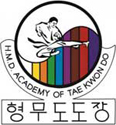Elaboration of the ideal of Tae Kwon Do can be initiated from the genealogy of Moo Do. Martial art is the translation of Moo Do. We can triangulate the meaning of Tae Kwon Do through understanding what Moo Do and martial arts signify. The Chinese character Moo consists of Guh and Ji . /Guh/ means "spear, attack, disturbance, and aggression" and /Ji/ means "to stop". Thus, /Moo/ together means "to stop the attack, disturbance, and aggression." This etymological analysis tells that Moo originates from the practice of halting and pacifying war or disturbance. In the context of modern life, we are involved in continuous disturbance: Even though we do not suppose an extreme event like war, our capacity as human beings are finite, we must face death regardless. Thus, we must accept that we cannot be totally free from disturbance, however, we can learn to manage the disturbances that plague us. We can view them as challenges to our lives. But to do so, we must enhance our capacity to deal with them. Construed in this way, Moo is a relevant practice to our everyday concern since it is the practice of cultivating our capacity to deal with the set of inevitable and contingent disturbances arising in our lives.
For the purpose of operational distinction, we can identify three major sources of disturbance. These are external, internal, and a combination of both. External disturbances are those which arise due to circumstances outside oneself. They include the threat of physical violence to oneself or one's fellows, or any obstacle which stands in the way of accomplishing one's goals. External disturbances also include societal problems such as oppression and discrimination.
Internal disturbances are those which arise from within one's own mind or body. They can take the form of basic physical needs or desires, such as food, shelter and sex. Or, they can be related to one's personality. For example, a lack of respect for others, a lack of ethics, irresponsibility, laziness, passivity, overconfidence, and aggressiveness can all contribute to conflict situations.
Finally, the source of disturbance may be both internal and external. In many cases the causes of disturbance will not be separate, but interactive. An external disturbance may provoke an internal response which causes conflict. Further, the effects of external disturbances usually become greater for those who are burdened with serious internal disturbances. For example, economic difficulties can cause the person of weak conscience to steal.
In practicing Moo Do we are training to develop a strong self, in order to overcome both external and internal sources of disturbance.
The attitude of the student determines the nature of his character development. We are not practicing in order to passively defend against every disturbance, but to approach disturbances as personal challenges which, when overcome, contribute to personal growth.
Again, this can be seen etymologically. The Chinese character /Do/ encompasses /Ji/ and /Su/. /Ji/ means walking, behaving, and bodily practice. /Su/ means face, head, mind, thoughts, and ideas. Thus, /Do/ together means 'the way to live a life within a harmonious unity of body and mind'.
Do deals with becoming the ideal self in relation to the entire dimension of living, including our relationships with nature, others, and society as a whole. The path of Do is grounded in the ethical; the mode of life one aspires to while rconciling our relationships with the latter. Thus, Do is a bridging principle between the individual and the larger social context. As a result, the path to Do demands philosophical self-reflecting, an understanding of 'Who am I?", and 'What is my moral relation to nature and society?' That is, understanding oneself as an individual, as well as part of a larger whole.
By articulationg the meaning and value of nature, others, and society, each individual is able to create his/her own way of life. This ethic must become routine, eventually subconscious as the martial artist progresses to his/her full potential. That potential is realized when the martial artist fully knows him/herself and in turn transcends that self for the good of society. This is the art of living, and the goal of Moo Do.
